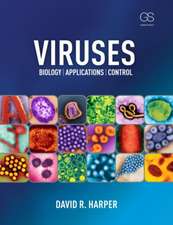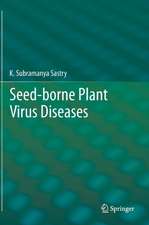Ultrastructure of Bacterial Viruses
Autor Anna S. Tikhonenkoen Limba Engleză Paperback – 25 feb 2012
Preț: 715.55 lei
Preț vechi: 753.22 lei
-5% Nou
Puncte Express: 1073
Preț estimativ în valută:
136.94€ • 142.59$ • 115.73£
136.94€ • 142.59$ • 115.73£
Carte tipărită la comandă
Livrare economică 07-21 martie
Preluare comenzi: 021 569.72.76
Specificații
ISBN-13: 9781468417814
ISBN-10: 1468417819
Pagini: 308
Ilustrații: X, 294 p.
Dimensiuni: 152 x 229 x 16 mm
Greutate: 0.41 kg
Ediția:1970
Editura: Springer Us
Colecția Springer
Locul publicării:New York, NY, United States
ISBN-10: 1468417819
Pagini: 308
Ilustrații: X, 294 p.
Dimensiuni: 152 x 229 x 16 mm
Greutate: 0.41 kg
Ediția:1970
Editura: Springer Us
Colecția Springer
Locul publicării:New York, NY, United States
Public țintă
ResearchCuprins
1. Electron-Microscopic Methods of Investigation of Bacteriophages.- The Supporting Grids.- Preparation of the Mounting Film.- Methods of Preparing Suspensions of Bacteriophages.- Methods of Obtaining Concentrated Suspensions of Phages.- Purification of Biological Preparations.- Contrasting of Objects.- Methods of Fixation of Bacteria for Preparation of Ultrathin Sections.- Terminology.- 2. Classification of Phages Based on Morphological Characteristics.- 3. Filamentous Phages and Phages with Tail Analogs.- Filamentous Phages (Group I).- Phages with Tail Analogs (Group II).- 4. Short-Tailed Phages (Group III).- Subgroup I: Phages of Type T3 and T7.- Subgroup II: Phages of Type P22, sd.- 5. Phages with a Noncontracting Tail (Group IV).- Structural Variation among Phages with a Noncontracting Tail.- 6. Phages with a Tail Possessing a Contractile Sheath (Group V).- Phage T2 HO.- Phage No. 1 of Bacillus mycoides.- Phage N19 of Bacillus mycoides.- Phages of Bacillus subtilis.- Staphylococcal and Streptococcal Phages.- 7. Defective Phages and Bacteriocins.- 8. Action of Chemical and Physical Agents on Various Phages.- Action of pH.- Urea and Other Agents Breaking Hydrogen Bonds.- Detergents.- Freezing and Thawing.- The Effect of Temperature.- Action of Adenosinetriphosphatase on Phages.- 9. The Aggregative Properties of Phage Proteins.- Polysheaths.- Polyrods.- Polyheads.- 10. Phosphatase Activity of Phages and Some Properties of the Contractile Phage Protein.- Localization of Phosphatase Activity in Structural Elements of Phage T2.- Physicochemical Properties of the Contractile Protein of Phage T2.- 11. Organization of Phage DNA During Its Replication in the Bacterial Cell.- Conclusion.- Literature Cited.




